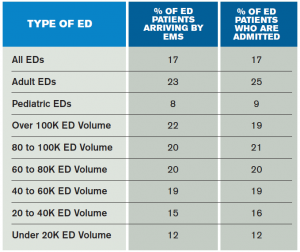The ambulances keep rolling, and for many years, the majority of their trips ended with a patient entering the emergency department. But a new paradigm is evolving, and it is likely that significant changes are ahead in the relationship between the providers of emergency medical services (EMS) and the ED.
Explore This Issue
ACEP Now: Vol 33 – No 12 – December 2014The 2013 Emergency Department Benchmarking Alliance (EDBA) data survey gathered performance measures from more than 1,300 participating EDs. This survey has a 10-year trend line demonstrating that a very consistent percentage of ED patients arrive on an ambulance stretcher and that a large number of those patients will receive diagnostic testing in the ED, initial treatment, and then admission to an inpatient unit of that hospital or another one offering a higher level of service.
Specifically, the EDBA survey asked member EDs to report the percentage of patients who arrive by EMS and those who arrive by EMS and are admitted from the ED to the hospital. EMS arrival rates are higher in those EDs with larger volumes and by far highest in EDs serving adults, where about 23 percent of patients arrive in an ambulance. Ambulance arrival rates average around 12 percent in smaller-volume EDs and about 8 percent in EDs that serve only pediatric patients.
In 2013, about 17 percent of patients seen in the ED arrived by EMS, a percentage that has been very consistent over the last 10 years. There is close correlation between EMS arrival and the overall admission rate from the ED, as shown in Table 1, with larger-volume and adult-serving EDs having higher admission rates and higher EMS arrival rates.
There are evolving models of unscheduled care that have EMTs and paramedics providing a variety of patient care services outside of the traditional transportation model.
Trending the EDBA data over the past 10 years finds that EMS arrivals and admission rates are very stable and that patients arriving by ambulance continue to represent higher acuity than those arriving in a private automobile or other conveyance. Table 2 demonstrates that about 39 percent of EMS-arriving patients are admitted. That means patients arriving by other means have a significantly lower admission rate, at about 12.5 percent.
There are evolving models of unscheduled care that have EMTs and paramedics providing a variety of patient care services outside of the traditional transportation model. The term that has been applied is mobile integrated healthcare practice (MIHP). This is a novel and evolving health care delivery platform intended to serve a range of patients in the out-of-hospital setting by providing patient-centered and team-based care using mobile resources. This has included programs to provide follow-up care for patients released from inpatient status back to their home, patients with recurrent admissions for long-term health problems like congestive heart failure, and patients with a variety of health problems who have demonstrated frequent use of EMS service in the past.
Pages: 1 2 3 | Single Page








No Responses to “Emergency Medical Services Arrivals, Admission Rates to the Emergency Department Analyzed”